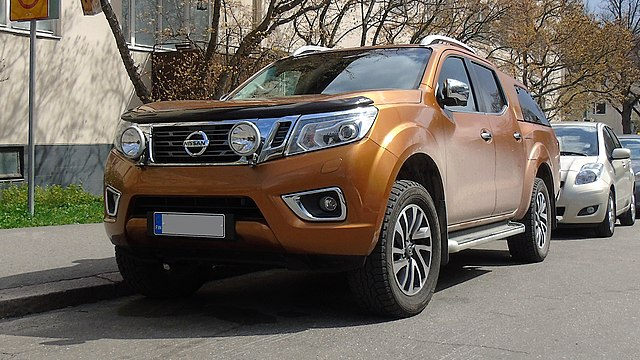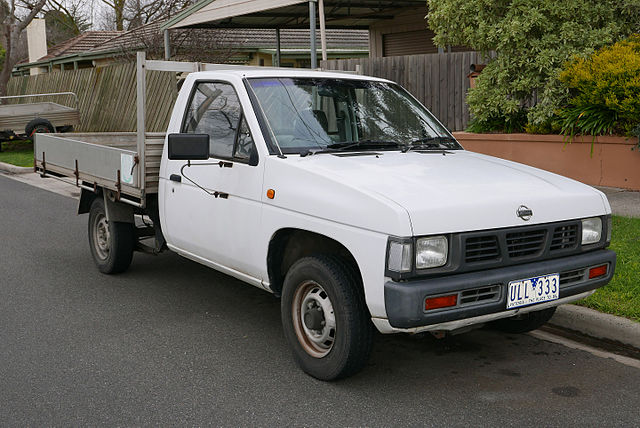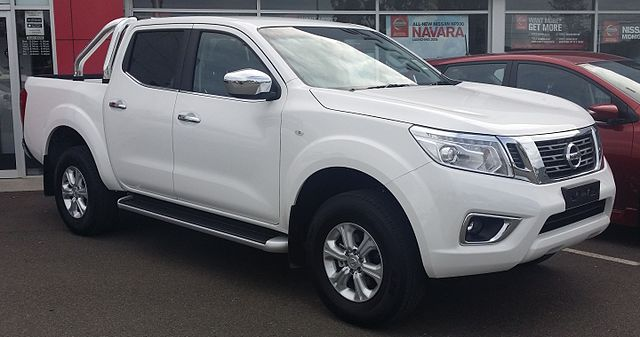The Nissan Frontier (also known as Nissan Navara in some markets ) is a pick-up truck that has been produced by the Japanese car manufacturer Nissan since 1986, now in its fourth version. The two models come from the former automobile brand Datsun, where they bore the name Datsun Truck.
Nissan Frontier / Navara (D21) 1st Generation (1986-1997)
The first generation of the Nissan Turck (D21) was introduced in May 1986 as the successor to the Datsun 720 and was primarily intended to compete against the competitor Toyota Hilux.
The Nissan pickup was marketed under different names depending on the sales market. While the names "Datsun D21" and "Nissan Datsun" prevailed on the domestic market, it ran in China and Europe as "Nissan D21", and in Australia as "Nissan Navara".
The D21 Pickup earned the nickname "Nissan Hardbody" in the US market due to its rugged looks and double side panels. The Nissan D21 sold very well worldwide and was soon known for its reliability and high utility.
In the same year, Nissan introduced the two-door SUV Pathfinder WD21. This was derived from the D21 pickup and shared the look and most of the components.
The Design
The low-cost Nissan D21 truck was available in Standard Cab, King Cab with extended cab, and four-door Double Cab with shortened bed (1.37 m). The latter was not available on the US market. When it came to the loading area, the buyer could choose between the "standard" version with a platform length of 1.83 m and the "long" version with 2.13 m.
Visually, the new Nissan pickup differed from the previous model primarily in its less angular design and more aggressive appearance. It also had two larger headlights instead of the small twin headlights of the Datsun 720.
The Nissan D21 was available in three trim levels: Standard, XE, and SE. A "Value Package" was also available for the XE line from 1994, which included, among other things, air conditioning, electrically adjustable exterior mirrors, alloy wheels, and additional chrome trimmings on the mirrors and bumpers.
Standard SE trim included a rear locking differential, sunroof, power windows, and central locking. Air conditioning, rear sliding windows, radios, or rear bumpers could be ordered as options. From 1996 driver's airbag and ABS on the rear axle were standard. The Nissan D21 was replaced by the successor model Nissan D22 in 1997.
The Power
Both in-line four-cylinder and V6 engines were available for the D21 pickup. The diesel engines of the previous model were also available in Europe. The 2.4-liter four-cylinder produced 107 hp and was replaced in 1990 by the 100 kW/135 hp 2.4 l R4 SOHC engine.
With 103 kW/140 hp, the 3.0-liter V6 VG30i initially had only slightly more power and was replaced in 1990 by the more powerful VG30E with 114 kW/155 hp. The diesel engines had a displacement of 2.3 liters to 2.7 liters and covered a power range from 59 kW/80 hp to 73.5 kW/100 hp.
A five-speed manual was used as standard in the Nissan D21, with a four-speed automatic being available as an option for some models. The buyer could also choose between rear and all-wheel drive.
Nissan Frontier / Navara (D22) 2nd Generation (1998-2004)
The second generation of Nissan Truck (D22) replaced the previous model Nissan D21 in 1998. The compact pickup was named after the Spanish province of "Navarra". Depending on the country of sale, the Nissan D22 was also known as "NP300" (Mexico, parts of Europe), "Terrano" (Chile), "Datsun" (Japan), and "Nissan Pick Up" (Africa, Asia, South America).
In North America, Argentina and Brazil, the D22 model was introduced as the "Nissan Frontier", replacing the D21 "Hardbody". During its construction, the Nissan Frontier D22 received several facelifts, mainly affecting the pickup's front. Among other things, it received a new radiator grille, new headlights, and a chrome bumper, which made it look sportier and more dynamic. The driving characteristics of the pickup have also been improved, and the interior upgraded.
The Design
The significantly modernized Frontier D22 was available as a single cab with a wheelbase of 2,650 mm and as a two-door king cab - from 1999 also as a four-door double cab - with a wheelbase of 2,950 mm. From 2002, an extended version with a wheelbase of 3,300 mm was also available for the model with a double cab. At 1,895 mm, it offered the longest loading area in its class.
Like its predecessor, the Frontier D22 was available in Standard, XE and SE trim levels.
The models already had ABS, driver and passenger airbags, 3-point safety belt, 14-inch steel wheels, halogen headlights, black radiator grille, bed attachment hooks, double side walls, removable tailgate, flexible loading system, vinyl bench seat for three people, two headrests and 2- Gear wipers.
XE models also featured power steering, 15-inch alloy wheels, dual door mirrors, chrome grille and bumpers, CFC-free air conditioning, digital clock radio, carpeting, and an optional 4-speed automatic.
The SE trim level included fender flares, a glass roof with sunshade, cloth bucket seats, cruise control, tachometer, rear sliding window, tinted glass, and body-side graphics. In addition, Nissan offered a variety of trim levels and optional extras to customize the pickup.
The Power
During its production, various gasoline and diesel engines were available for the Nissan Frontier D22. 2.4-liter SOHC four-cylinder gas engines delivered between 107 kW and 110 kW and had a torque of 198 Nm to 209 Nm. A 120 kW 3.0-liter V6 engine was later added to the gas range.
The diesel engines had a displacement of 2.5 liters to 3.3 liters and covered a power range from 98 kW to 125 kW. At the beginning of 2003, the last and most powerful engine was the 3.3-liter V6 engine with a supercharger, which delivered 157 kW.
Depending on the model and equipment, the Nissan Frontier D22 was equipped with rear or all-wheel drive, a 4 or 5-speed manual gearbox, or a 4-speed automatic. In 2004 the Nissan Frontier II production ended, which was replaced by the new model Frontier D40 in 2005. However, in South Africa and some other countries, the D22 is still being built to this day.
Nissan Frontier / Navara (D40) 3rd Generation (2005-2015)
The third generation of the Nissan Frontier, the D40 model, made its debut at the 2005 Geneva Motor Show and went on sale worldwide in July. With a wheelbase of 3.20 meters and an overall length that has grown to 5.22 meters, it had grown significantly in size compared to the previous D22 model and was now driving in the mid-size pickup segment.
Just one year after it went on sale, the Nissan Frontier pickup made it to the top of the segment and in 2006, with a total of 45,200 new registrations, took around 25 percent of the pickup segment market share.
The Design
In the Frontier D40, Nissan combined the practicality and robustness of a traditional pickup truck with the comfort of an SUV for the first time. It is, therefore, not surprising that the majority of the Pathfinder's mechanical components and many comfort features developed simultaneously could be found in the Frontier pickup.
The modern interior with comfortable individual seats, a chic cockpit, on-board computer, and numerous chrome applications was by no means common in the pickup segment. Both vehicles rolled off the assembly line side by side at Nissan's Barcelona plant in Europe. Models for the South American market were produced in São José dos Pinhais, Brazil.
The relationship to the Nissan SUV was also evident from the outside because both models looked almost the same up to the A-pillar – the differences only began after that. Dominating the front of the Frontier was the three-piece radiator grille, divided by diagonal chrome bars, which was also the "face" of the Pathfinder.
The Nissan Frontier was based on a robust ladder frame chassis on which the body and axles were mounted. An independent wheel suspension with double wishbones and coil springs was used on the front axle, while the pickup had to make do with rigid axles, leaf springs, and drum brakes at the rear. Depending on the equipment and engine, the Frontier pickup can take between 2.6 and 3 tons on the hook.
The fourth-generation Frontier was offered in King Cab and Twin Cab versions in XE, SE, LE, and Platinum EVO trim levels. The four-door King Cab version had two full front seats and two folding jump seats. The rear "easy-walk-in" doors could be opened at a 90-degree angle and facilitated entry. The Frontier King Cab offered the largest cargo space in its class, with a cargo bed measuring 1,130mm wide and 1,860mm long.
The four-door Frontier Double-Cab variant had a three-seater rear seat and offered space for up to five adults with the extended passenger cabin. However, the double cab had to make do with a slightly shorter loading area of 1,511 mm. The double cab was optionally available as a long bed with a loading platform that was 100 mm longer.
Nissan offered numerous extras to secure cargo in the loading area. For example, a system with five aluminum rails in the floor and side walls of the loading area, in which there were sliding, self-closing clamps as fixed points for lashing. A hard top cover, a toolbox, a tent for the truck bed, and a bike rack were also available as options for the Frontier pickup.
The standard equipment of the Frontier D40 pickup included, among other things, height-adjustable headrests, airbags for the driver and front passenger, as well as switchable all-wheel drive with off-road reduction ESP, ABS, EBD, and a brake assistant. But also 17-inch alloy wheels, a lockable tailgate, a rear underride guard (only on the XE), central locking, and power windows were on board ex-works.
Depending on the equipment line, the Frontier had electrically adjustable exterior mirrors, fog lights, side running boards, a chrome-plated step in the rear bumper, an integrated radio/CD combination with Bluetooth interface, AUX/USB connection, and a cruise control system with speed limiter function.
In addition to manual air conditioning, the optionally available air conditioning & safety package included a radio/CD combination with Bluetooth® interface, central locking with radio remote control, heated seats, a fresh air filter, and an onboard computer.
The Power
When the Nissan Frontier was launched, it was powered by a 2.5-liter turbo diesel engine with variable turbine geometry. It delivered 128 kW/174 hp and developed a maximum torque of 403 Nm. After a revision in 2010, the power was increased to 140 kW/190 hp and the torque to 450 Nm. It reached a top speed of 112 mph (automatic: 110 mph).
As of the model year 2010, the top engine for the Frontier pickup was a 3.0-liter V6 engine with a rated output of 170 kW/231 hp and a maximum torque of 550 Nm. It reached a top speed of 121 mph and met the Euro 5 emissions standard. The Frontier V6 pickup was mated to a seven-speed automatic transmission as standard and had a towing capacity of 3 tons.
For Frontier models with XE equipment and 6-speed manual transmission, Nissan also offered a version of the 2.5 dCi engine throttled to 106 kW/144 hp. It had a maximum torque of 350 Nm and a top speed of 105 mph. The fourth-generation Nissan Frontier was also offered with a 198 kW 4.0-liter V6 engine.
There was no permanent all-wheel drive on the rear-wheel drive Nissan pickup. This could be activated electronically using a rotary switch on the dashboard, producing a balanced (50:50 percent) torque distribution between the front and rear axles. For use in particularly difficult terrain, the Frontier D40 also had an off-road reduction and an automatic locking differential with limited slip.
Together with a ground clearance of 217 mm, a wading depth of 450 mm, departure angles of 30 degrees at the front and 24 degrees at the rear, and ramp angles at the front and rear of 22 degrees each, the Frontier pickup mastered many a terrain.
In 2010, the Japanese manufacturer Nissan recalled 2.14 million vehicles worldwide to the workshops. This also includes the Nissan Frontier D40 built between 2005 and 2006. Due to a possibly defective relay unit for the engine control unit, the power supply to the control unit could fail, and the engine could suddenly stop while driving.
2011 was followed by another global recall of 193,508 Frontier construction period June 1, 2005, to July 3, 2008. The reason was the spokes of the rim star, which could tear under constantly increased loads, which could lead to the rim star breaking.
Nissan Frontier / Navara (NP300) - 4th generation (Since 2015)
At the IAA 2015, the Japanese presented the 4th generation of the Nissan NP300 Frontier pick-up (on certain markets also called Navara), which is offered on the market worldwide. It had already celebrated its world premiere in Thailand, where it was first sold. In Europe, it rolled to the dealers in January 2016.
The Design
The Nissan pickup is still available as a king cab and as a double cab. With regard to the European market, the one-ton flatbed truck appears in a new crossover look with comfort equipment that is more reminiscent of SUVs than commercial vehicles and should make the pick-up suitable for everyday use and families.
But despite all the modernizations, the Frontier's workhorse genes remain fully intact and confidently follow in its predecessor's footsteps. Even more, the first Japanese pickup was a double cab equipped with coil springs for the rigid axle. On the other hand, the King Cab version comes with a completely revised leaf spring suspension. This translates into a weight loss and an improved departure angle. The new rear suspension and the wheelbase reduced by 50 mm (now 3,150 mm) ensure better handling of the Frontier.
The payload of the new Nissan pickup is one ton, and the towing capacity has been increased to 3.5 tons. The length of the loading area in the Double Cab version is 1,578 millimeters (67 mm longer than in the predecessor) and represents the best value in the segment.
In the King Cab variant, the platform length is 1,788 millimeters. For the best possible use of this area, there are aluminum rails all around for the lashing system. Nissan offers a five-year or 100,000-mile limited warranty for the Frontier pickup.
Gone are the days when you had to choose between high utility and comfort. A completely optimized driver's cab brings additional space and functionality. Looking at the cockpit, you might forget for a moment that you are in a pick-up truck. The curved dashboard with an onboard computer and the multifunction steering wheel is much more reminiscent of the manufacturer's current SUV models.
Since the new Nissan pick-up as a double cab should also be well received by families, Nissan has also paid special attention to the rear row of seats: More comfortable seats, enough space for Isofix child seats, and their own ventilation should also enable passengers in the back seat to having the best possible comfort.
Nissan offers an extensive range of accessories for its latest pick-up. These include extendable loading areas, metal steps, tailgate dampers, load carriers, loading space covers, and much more.
The Power
Under the hood of the new Frontier is a 2.3-liter dCi diesel engine which, according to Nissan, is up to 24 percent more economical than its predecessor. The four-cylinder diesel engine is available in two power levels: the 118 kW/160 hp version and the twin-turbo variant with 140 kW/190 hp.
The power transmission takes over a six-speed manual transmission or a seven-speed automatic. All-wheel drive, which can be switched on at the push of a button, is standard on the Frontier pick-up; only the entry-level King Cab version is also available with purely rear-wheel drive.
While in other pick-ups you can feel the “jerking” that is typical of pickup trucks, the double-cab version of the Frontier masters such bumps with ease. This is thanks to a completely newly developed multi-link rear wheel suspension with coil springs.
The King Cab version is still on the road with leaf spring suspension, but this has also been revised - it promises better handling, weighs less, and has a more favorable rear departure angle.
The new Frontier is the first pick-up truck to have an autonomous emergency brake assistant. Another real benefit is the Around View Monitor, which shows the vehicle from a bird's eye view and provides a 360-degree all-round view.
Hill climb and hill descent assistants are standard on all variants with selectable all-wheel drive. Depending on the variant, a cruise control system, an electronically controlled limited-slip differential, and a keyless start system also come as standard.
Protecting Your Nissan Frontier / Navara
Over generations, Nissan Frontier / Navara has established itself as a popular pick-up as well as an off-road vehicle both in the USA and Europe. Like every truck, it’s not always easy to find any protective equipment to buy for the Ranger.
As always, we recommend Coverking. They have custom protective equipment ready for any vehicle on the market anytime. Check out their catalog and see for yourself. Coverking is the official protective equipment supplier for most automotive brands. So, the manufacturers agree that they are the best.
Resources
- https://en.wikipedia.org/wiki/Nissan_Navara
- https://navlife.com.au/the-history-of-navara/
- https://www.gaukmotors.co.uk/car-make/nissan/navara
- https://www.autoevolution.com/nissan/navara-frontier-king-cab/
- https://www.hotcars.com/nissan-navara-incredible-evolution/
- https://www.goauto.com.au/used-car-research/nissan/navara.html
- https://tractors.fandom.com/wiki/Nissan_Frontier
Tankut Basar
Tankut Basar is an ARA (American Rally Assoc.) Racing Driver and an FIA Bronze Category License Holder. His passion for driving began with karting like most racers. He started racing internationally at the age of 22. Tankut loves everything car-related and will keep enjoying the drive until the end.








